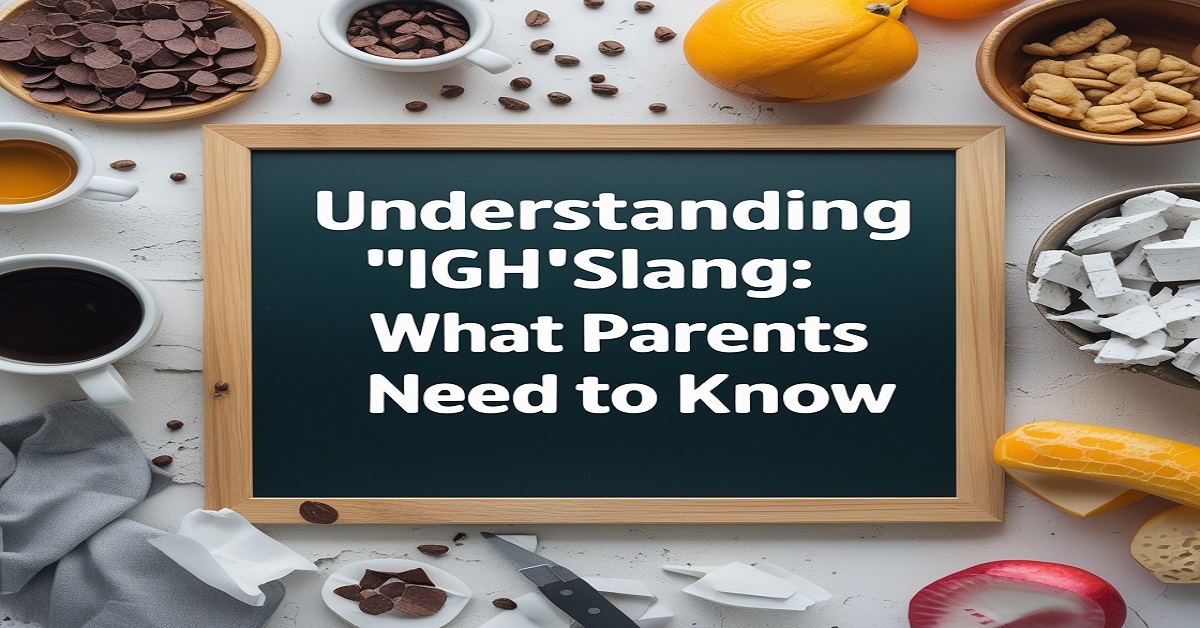We’ve all been there. Your teen sends you a text or drops a message on social media, and you’re left staring at the screen, wondering if they’ve suddenly developed their own secret code language. The latest head-scratcher? IGH. No, it’s not the next big conspiracy theory or a rare medical condition—it’s just a shorthand way your kid might say “alright”.
But before you start Googling “what is IGH slang?” and end up falling into a rabbit hole of Internet jargon, let’s break it down and give you the lowdown in a way you can actually use to impress your teen.
What Does IGH Stand For?
First things first: IGH is the abbreviated form of “Alright.” But it’s not just some random collection of letters your child picked up out of the blue. IGH is a quick way of saying, “I get it,” “I agree,” or “Yeah, I understand.” Think of it like a verbal high-five in text form—just a simple, cool shorthand to keep conversations flowing.
Now, you might be thinking, “Wait, they could just type out ‘alright’—why the rush to shorten it even more?” Well, the answer lies in the fast-paced world of texting and social media, where every character counts. Plus, it’s kind of like an inside joke between teens. If you know, you know.
How Do Teens Use IGH?
Picture this: You’re texting your teen, and they ask you a question, like, “Can I go to the movies tonight?” Now, instead of typing out a whole sentence like “Okay, that sounds good,” your kid might just drop an IGH. It’s like their way of saying, “Yeah, sure, I’m cool with that.”
But it’s not just for saying “yes.” Teens also use IGH to acknowledge something without actually saying much at all. It’s a quick “I hear you” or “I got the message.” It’s like a verbal shoulder shrug—casual, to the point, and totally chill. And while it might seem like a small thing, it’s an essential part of how they communicate in their digital world.
Real-Life Scenario: Using IGH in Action
Let’s paint a picture: Imagine your teen is messaging with their friend about their plans for the weekend.
Teen 1: “Hey, you wanna hit up the mall Saturday?”
Teen 2: “IGH, sounds good. I’ll pick you up at 1.”
In this scenario, “IGH” is a quick response to indicate that Teen 2 is on board with the idea. It’s casual, direct, and to the point—no need for any unnecessary fluff. Now, you might be thinking, “What if my teen just drops IGH in the middle of a conversation and I have no idea what it means?” Well, don’t panic. It’s just their way of saying they’re listening or that they understand.
IGH and Teen Lingo: The Bigger Picture
IGH is part of a larger trend of teen slang that relies on abbreviations and shorthand expressions. And as parents, it can feel like trying to keep up with a moving train when it comes to understanding all the new lingo. But here’s the thing: it’s not as complicated as it might seem.
If you’ve ever found yourself Googling “What does lit mean?” or “Why is everyone calling things fire?”—you’re not alone. Slang evolves fast, and IGH is just one example of how teens are creating their own digital language to communicate quickly and efficiently. It’s a way to bond with friends, build inside jokes, and keep things light and fun. So, while it might seem like a mystery, once you crack the code, you’ll be texting like a pro.
Why Do Teens Love Using IGH?
One reason IGH (and similar shorthand terms) has become popular is because it saves time. In a world where we’re constantly bombarded with information, every second counts. Teens are masters of efficiency in the texting world, and abbreviations like IGH allow them to get their point across without typing out a full response.
Another reason? It’s just fun. Using slang is part of how teens create their own culture, and when you use IGH, you’re in the “in crowd.” It’s like having a secret handshake, except it’s digital. It’s their way of showing they’re part of something cool and unique.
Common Misconceptions About IGH
Now, let’s clear up a few things. If you’re reading this and thinking, “Wait, doesn’t IGH mean something else? Like a typo or a mistake?” You’re not wrong to be confused. Sometimes, slang terms get mixed up or used in different ways depending on the platform or the context. But in the case of IGH, the most common meaning is “Alright.”
But what about the times when IGH might seem out of place? Perhaps your teen sends it in a situation where it doesn’t feel quite right. Here’s the thing—language is fluid. Sometimes, teens might throw IGH into a conversation just because it sounds cool, even if it doesn’t strictly fit the situation. So don’t be alarmed if you see it used in a way that feels a bit off. It’s all part of their evolving language.
IGH vs. Other Slang Terms: What’s the Difference?
Teens are notorious for their ever-expanding vocabulary. And while IGH is a go-to for many, there are plenty of other abbreviations that might pop up in your teen’s texts. Let’s take a quick peek at a few of the most common ones and how they differ from IGH:
- BTW (By The Way): This one’s pretty self-explanatory. It’s used to add an extra tidbit of information, like when you’re casually dropping a new fact into the conversation. “BTW, the movie starts at 7.”
- LOL (Laugh Out Loud): A classic! Used when something’s funny. “That meme was hilarious, LOL!”
- TMI (Too Much Information): Used when someone shares something too personal or unnecessary. “Ew, that’s TMI about your day at the dentist.”
- SMH (Shaking My Head): For when you can’t even. “He spilled his drink again… SMH.”
Each of these abbreviations has its own specific meaning and is used in different ways, but all serve the same purpose: helping your teen communicate in a quicker, more efficient way.
How Parents Can Keep Up with Slang
Let’s face it—trying to keep up with teen slang is like chasing after a speeding train. It can feel like you’re always a step behind. But don’t worry, you’re not alone in this! Here are a few tips for staying on top of the slang game:
- Ask Questions: If you don’t understand what your teen is saying, ask! Teens appreciate it when you show interest in their world (even if they roll their eyes).
- Stay Open-Minded: Don’t dismiss slang just because it’s new or unfamiliar. Understanding it can help you connect with your teen in a way that shows you’re not just the “old” parent.
- Use Slang (Sparingly): Want to really impress your kid? Use a little bit of slang yourself! Just don’t overdo it—nobody wants to hear you try too hard. A casual “IGH” here and there will do the trick.
Conclusion: Are You Ready to Speak IGH?
So, the next time you see IGH pop up in a conversation, you’ll know exactly what it means. And while there’s no guarantee that your teen will stop using abbreviations altogether (they won’t), at least you’ll have a few tools in your slang arsenal to keep the conversation going.
Now, I want to hear from you—what other teen slang confuses you? Or better yet, what new slang term has your teen dropped that you’ve had to Google? Let’s keep the conversation going and learn together!
FAQs About IGH Slang: Everything Parents Need to Know
- What does IGH stand for? IGH is short for “Alright.” It’s a quick, casual way for teens to acknowledge something, show agreement, or say they understand.
- How do teens use IGH in conversations? Teens use IGH as a shorthand to confirm that they’re on board with something or that they get what’s being said. For example, if someone says, “Let’s meet at 5,” the reply could be “IGH,” meaning, “Got it, that works.”
- Is IGH only used by teens? While IGH is most common in teen slang, anyone who enjoys texting quickly and informally might use it. It’s just part of a broader trend of digital shorthand that helps people communicate faster.
- What’s the difference between IGH and other abbreviations like LOL or TMI? Each slang term has a different meaning. For example:
- LOL means “Laugh Out Loud” and is used when something is funny.
- TMI stands for “Too Much Information” and is used when someone overshares.
- IGH, on the other hand, simply means “Alright” or “I understand.”
- Can I use IGH in my own messages to my teen? Absolutely! If you feel comfortable, using IGH here and there can show your teen that you’re in the loop. But don’t overdo it—it’s about using it naturally, not forcing it.
- What should I do if I don’t understand a slang term like IGH? Don’t be afraid to ask your teen what a term means! Teens usually appreciate when you show interest in their world, and it opens up a chance for a fun conversation.
- Are there other slang terms that I should know about? Yes, there’s a whole dictionary of teen slang! Some other common terms include:
- BTW (By The Way)
- SMH (Shaking My Head)
- YOLO (You Only Live Once)
- FOMO (Fear Of Missing Out)
- Why do teens use abbreviations like IGH instead of writing full words? Abbreviations save time and make texting faster. It’s also a fun way for teens to create a sense of community and keep their conversations casual and cool.
- What if I don’t want to sound like I’m trying too hard? If you want to use slang, keep it natural. A casual “IGH” once in a while is fine, but don’t overdo it. Teens will appreciate you trying to speak their language, as long as it doesn’t sound forced.

Tony James is a passionate wordsmith and the creative force behind Winky Hive. With a knack for uncovering the stories behind slang and weaving emotions into poetry, Tony brings a unique voice to every piece he writes. A lifelong lover of language, he thrives on exploring how words evolve, connect, and inspire.
When he’s not penning articles or crafting verses, Tony enjoys diving into cultural trends, reading classic poetry, and discovering hidden gems in modern expressions. His mission? To make Winky Hive a haven for those who love the art of language in all its vibrant forms.









